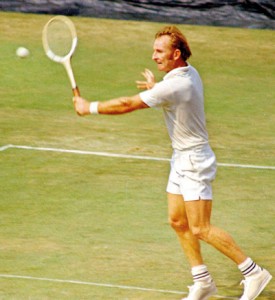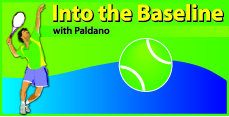Rise and survival of Australian tennis
January signals the start of the global Tennis calendar. Its summer now in Australia and it is their time for sports, Santa Claus and barbeques. The best Tennis players of the world will congregate in Brisbane, Sydney and of course Melbourne to kick off the season. Sports is a big part of Australian social life and they indulge in participation and in discussion, passionately.

Rod Laver, in action
Melbourne’s Australian-Open Championship is one of the four Grand-Slam events in the global Tennis calendar. The four Grand-Slam events are a privilege of the first four countries which won the “Davis-Cup”, the inter-nation Tennis Championships started by Dwight Davis of USA over 100 years ago. At one point in time the annual global tennis calendar had only these four events. They sustained Tennis interest into what it is today. It is a phenomenal success story of sports. It is this factor that made many countries to have national championships in a grand scale.
Last straw
Unfortunately, the Australian-Open and their events in summer has dwindled down to be Australia’s last straw of attachment to international Tennis. As for players, they talk about the ones who played in the past. In the last two decades, the Australian output of ‘world beaters’ has trickled down to a count of less than five. In the ‘seventies’ ten of the top twenty, were Australians. One would recall famous Australian names such as Rod Laver, Frank Sedgeman, Ken Rosewall, John Newcombe, Roy Emmerson and Fred Stolle from the 60’s and 70’s. They made ‘world Tennis news.’ Most of them came through Harry Hopman’s Davis Cup team building pursuit.
In the late 1970’s working on a coaching stint with the late Harry Hopman, the legendary Australian coach in West Germany, I vividly recall his prediction to West German champion, Wilhelm Bungert as to what would become of Australian Tennis. His prediction has come true exactly as he stated. Hopman cited the need to ‘foster the whole game and not parts of it.’ What he meant by this is making departments for Tennis activities for various conveniences was not the right thing. Even in teaching his approach was holistic. He sensed playing too much with the time tested format which has evolved and not staged, is a dangerous for the future of Tennis.
Hopman was so disappointed with Australia in the seventies, left and started his own system in Europe. His development foundation is a major factor behind continental Europe’s Tennis boom. Sports development and management are fragile and can very easily retreat to nothing. A  phenomenon not fully understood nor paid attention to by sports administrators worldwide. Australian fate is probably being experienced in England, the USA, Germany and India, is now touching Spain as well. If this could happen to such countries, we have to admit that no country is immune to it. Many join sports administrations to ride the crest for the spoils and not for the game. There is very little insurance against it except the ‘sincerity of purpose’ of those who take on the responsibility.
phenomenon not fully understood nor paid attention to by sports administrators worldwide. Australian fate is probably being experienced in England, the USA, Germany and India, is now touching Spain as well. If this could happen to such countries, we have to admit that no country is immune to it. Many join sports administrations to ride the crest for the spoils and not for the game. There is very little insurance against it except the ‘sincerity of purpose’ of those who take on the responsibility.
Asia’s focus
The women’s professional body the WTA and men’s, the ATP considers Australian-Open to be a mandatory event to its membership. To enhance the appeal, the event offers prize money to the tune of 36 million Australian dollars. Singles winners will take home three million dollars each. The 2014 ranking will decide the seeding and the cut off mark for entries into the 2015 Australian-Open main draw, which begins in mid January. Generally the cut off mark for direct entry for Grand-Slams is 160 in the annual ranking. It goes to show that the four Grand-Slams depend on other global Tennis events for their success. In any international sport, no event can stand alone to sustain its existence.
World professional Tennis maintains up to 2000 positions based on a points system. The WTA and the ATP have second and third tier events worldwide designed for players in the lower rankings in all four corners of the world. It is in this context that Asi’s representation in the ranking has become insignificant. While Japan’s number one Kei Nishikori is enjoying a top ten position and Li-Na’s legacy is encouraging. The representation of Asians in the top 160 does not correspond to Asia’s population density. Only about four Asian countries have good targeted programmes towards the objective of placing players in the world rankings. Administrative approach and focus are the crux of the matter in this issue.
Primary events of Tennis
Tennis being a fiercely individualistic game sees singles dominate in prominence. The ‘doubles’ and ‘mixed doubles’ do not seem to get the patronage of good player’s because of their back to back involvement in singles on weekly basis. It is too big a challenge for players to get involved in doubles as well. Most of the best singles players do not play doubles anymore. If one does a study of the top five players in the world the last three decades, it consistently shows all leading players have been good doubles players.
In the three phases of a professional Tennis player’s career, doubles and mixed doubles play a significant role in the competition-maturity factor. It is through this player’s survival instincts, tactical game, physical needs and reactions mature for big events. Roger Federer was a high ranked doubles player and it is from this that his ‘all court’ game evolved. Doubles did have an esteemed status until the nineties. Right now, Doubles is helping players to remain in the game longer and not much more. There are moves to bring back doubles to the centre stage again.
Australian prospects
Australia has only about five players in the current top men’s 100. The best Australian at the moment is 21 year old Dominic Thiem ranked 39 in the world. The next best player is 33 year old Lleyton Hewitt who is a former number one in the world and he is ranked 50. Nineteen year old Australian Nick Kyrgios is currently ranked 52. Kyrgios performed well in the last Wimbledon and much is expected from him. Among the women, thirty-one year old Samantha Stosur ranked 22 is the best Australian player at the moment. Apart from her there are only two others in the top 100 of the women’s rankings. Australia has organised programmes, institutes and events even with these it has no players. Regretfully it is unlikely there will be an Australian in the 2015 Australian-Open semi-finals this year.
Much analysis is required to find the reason behind this dearth of Australian players. From what I have seen, most of the logical approaches in player development in Tennis have not produced much result. I firmly believe that Hopman’s observation reveals the reason behind the Australian issue. In the name of development, the game has been broken down into a piece meal of convenience.
Hopman always cited the need to foster the whole game and not parts of it. Harry Hopman was Davis cup captain turned coach of 22 Australian Davis Cup teams between 1939 and 1967. During this period Australia won the Davis Cup 15 times. Hopman understood ‘Tennis and Australia’. He was against breaking the game up for any convenience.
With or without local players, the Australian events of 2015 will provide great Tennis in the next three weeks attracting most of the best players in the world.
-George Paldano, former international player; Accredited Coach of Germany, National, Davis Cup and Federation Cup Coach, ITF and USPTR. [Mail - gptennis.ceylon@gmail.com-]


